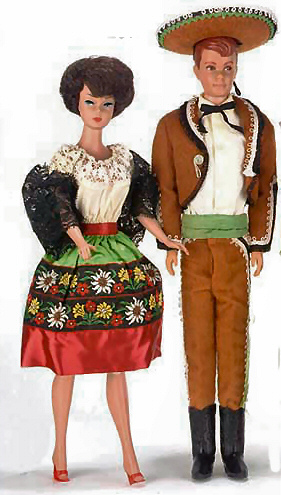
Vintage Barbie In Mexico
Overcoming Tourism by Hakim Bey
In the Old Days tourism didnt exist. Gypsies, Tinkers and other true nomads even now roam about their worlds at will, but no one would therefore think of calling them «tourists».
Tourism is an invention of the 19th century-a period of history which sometimes seems to have stretched out to unnatural length. In many ways, we are still living in the 19th century.
The tourist seeks out Culture because -in our world-culture has disappeared into the maw of the Spectacle culture has been torn down and replaced with a Mall or a talkshow- because our education is nothing but a preparation for a lifetime of work and consumption-because we ourselves have ceased to create. Even though tourists appear to be physically present in Nature or Culture, in effect one might call them ghosts haunting ruins, lacking all bodily presence. They're not really there, but rather move through a mindscape, an abstraction («Nature», «Culture»), collecting images rather than experience. All too frequently their vacations are taken in the midst of other peoples' misery and even add to that misery.
Recently several people were assassinated in Egypt just for being tourists. Behold .... the Future. Tourism and terrorism:-just what is the difference?
Of the three archaic reasons for travel - call them «war», «trade», and «pilgrimage» - which one gave birth to tourism? Some would automatically answer that it must be pilgrimage. The pilgrim goes «there» to see, the pilgrim normally brings back some souvenir; the pilgrim takes «time off» from daily life; the pilgrim has nonmaterial goals. In this way, the pilgrim foreshadows the tourist.
But the pilgrim undergoes a shift of consciousness, and for the pilgrim that shift is real. Pilgrimage is a form of initiation, and initiation is an opening to other forms of cognition.
We can detect something of the real difference between pilgrim and tourist, however, by comparing their effects on the places they visit. Changes in a place-a city, a shrine, a forest-may be subtle, but at least they can be observed. The state of the soul may be a matter for conjecture, but perhaps we can say something about the state of the social.
Pilgrimage sites like Mecca may serve as great bazaars for trade and they may even serve as centers of production, (like the silk industry of Benares) - but their primary «product» is baraka or maria. These words (one Arabic, one Polynesian) are usually translated as «blessing», but they also carry a freight of other meanings.
The wandering dervish who sleeps at a shrine in order to dream of a dead saint (one of the «People of the Tombs») seeks initiation or advancement on the spiritual path, a mother who brings a sick child to Lourdes seeks healing; a childless woman in Morocco hopes the Marabout will make her fertile if she ties a rag to the old tree growing out of the grave; the traveller to Mecca yearns for the very center of the Faith, and as the caravans come within sight of the Holy City the hajji calls out «Labbaïka Allabumma!» «I am here, O Lord!»
All these motives are summed up by the word baraka, which sometimes seems to be a palpable substance, measurable in terms of increased charisma or «luck». The shrine produces baraka. And the pilgrim takes it away. But blessing is a product of the Imagination-and thus no matter how many pilgrims take it away there's always more. In fact, the more they take, the more blessing the shrine can produce (because a popular shrine grows with every answered prayer).
To say that baraka is «imaginal» is not to call it «unreal». It's real enough to those who feel it. But spiritual goods do not follow the rules of supply and demand like material goods. The more demand for spiritual goods, the more supply. The production of baraka is infinite.
By contrast, the tourist desires not baraka but cultural difference. The pilgrim we might say - leaves the «secular space» of home and travels to the «sacred space» of the shrine in order to experience the difference between secular and sacred. But this difference remains intangible, subtle, invisible to the «profane» gaze, spiritual, imaginal. Cultural difference however is measurable, apparent, visible, material, economic, social.
The imagination of the capitalist «first world» is exhausted. It cannot imagine anything different. So the tourist leaves the homogenous space of «home» for the heterogenous space of «foreign climes» not to receive a «blessing» but simply to admire the picturesque, the mere view or snapshot of difference, to see the difference.
The tourist consumes difference.
But the production of cultural difference is not infinite. It is not «merely» imaginal. It is rooted in language, landscape, architecture, custom, taste, smell. It is very physical. The more it is used up or taken away, the less remains. The social can produce just so much «meaning», just so much difference. Once it's gone, it's gone.

